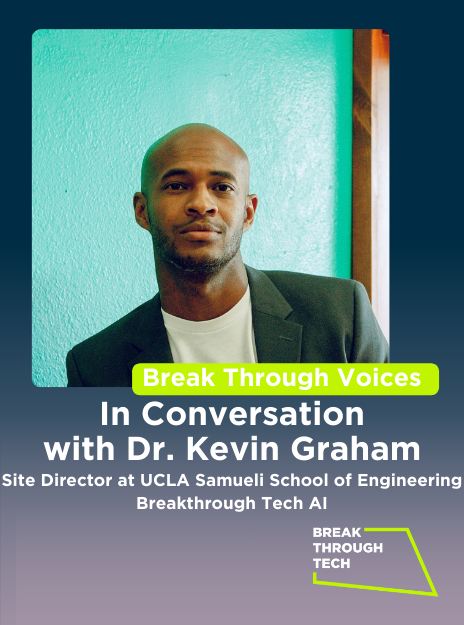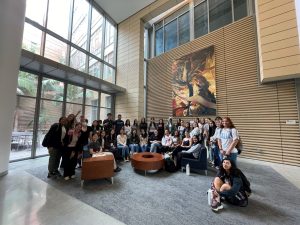
The best way to understand the shape and power of Break Through Tech’s work is to hear from the people who are part of it — from the young women participating in our innovative programs, to the leaders who host those programs inside their organizations and the team members who run our programs in cities around the country and online.
Meet Kevin Graham, Ph.D., Director of Break Through Tech AI at UCLA, a collaboration with the UCLA Samueli School of Engineering, often considered the Birthplace of the Internet. Launched in the summer of 2022, the program at UCLA serves a diverse community of undergraduate women,non-binary students and other systematically underrepresented individuals from across Los Angeles. In addition to being the entertainment capital of the world, the city is also home to many leading tech companies and startups in various industries, including aerospace, robotics, and gaming.
Kevin, what does this work mean to you personally? How does Break Through Tech’s mission line up with your own career focus?
Throughout my career I have focused on notions of equity and access. I have a background in higher education leadership and administration, and have worked to build bridges into higher ed for populations that are often underserved. I enjoy doing that work, and I consider it important.
During my time at UCR, I took on a project with Apple, using their coding curricula, and through that experience, I became keenly aware of the gender inequity in tech — data science, machine learning (ML), and artificial intelligence (AI). This opportunity with Break Through Tech AI appealed to me because it allowed me to continue working with first generation students, undocumented students, and students from households with limited income, while getting at the heart of a macro, systemic issue: the fact that women, female-identifying, and non-binary people are critically underrepresented in these fields.
This is not a new phenomenon. It’s something that’s been going on for decades and is well documented in the scholarship and service of individuals such as Dr. Safiya Noble, Dr. Ruha Benjamin, and Dr. Audrey Pool O’Neal . The saliency of this challenge spurred my interest to tackle an issue that adversely impacts a multiplicity of communities.
Imagine a world where Break Through Tech succeeds — we achieve our mission of breaking down the barriers that keep women and non-binary undergraduates from degrees and careers in tech. What will we have created? What will exist, that didn’t exist before?
The world would be wiser and more inclusive. The technology we use daily, like facial recognition — it has suffered because of the multiplicity of voices that are missing, the missing wisdom, the missing knowledge. If you look at tech, it has been unwise because of the exclusion of women and folks from systematically underrepresented communities. Something cannot become wise if it is not inclusive.
Tell me about your collaboration with industry partners. How would you describe their response to the Break Through Tech AI program?
They immediately get it. They know that voices are missing, that perspectives are missing. When my team and I do industry pitches — they understand the ask, often because of the effectiveness of the team of talented women ( Shahani Waas, Nicole Feliciano and Sofia Lee) that I work with, who are much smarter than I am. They are able to swiftly convey that Break Through Tech AI offers a path to a solution to this system issue. Oftentimes, if we are speaking to a self identifying man who represents a company, they’ve looked around and noticed, “there are a lot of individuals who look like me.” If the person that we are speaking with is a self identifying woman, they really get it. They understand the gap we’re working to close, and they understand their capacity to create positive change. Break Through Tech AI gives companies the ability to fast-track and/or actively participate in curating that change.
Is there a particular moment or experience with an industry partner that stands out for you?
Yes. Before I share it, let me say that one of my favorite features of our program here at UCLA is that we’re democratizing access to a top 25 computer science program, with a course taught by tenured professors, for communities who might not have access otherwise. Also, our cohort represents the expanse of higher education Southern California: community colleges, state institutions, other UC schools, and private institutions.
At this meeting, when this company learned we were serving students outside of UCLA, they were excited, because it allowed them to work with students from schools they otherwise would not recruit from. It was a moment where they recognized the opportunity to do something different that would in essence change the ethos of their company. They’d been drinking at the same watering hole for a long time, and if they drank from this different watering hole, it would change what the company looked like, felt like, sounded like, how they innovated, how they worked. It was exciting to see them recognize that, and be open to the change — to really see the value of working with schools not on their traditional recruitment list. And they didn’t just express interest — they committed, and I got to watch them experience the benefit of working with this expanded pool of students. There are other schools with students who are just as talented as those in the top 25 programs — that is the “aha!” moment. When you have a cohort of five students, and their work is stellar, that’s where bias disintegrates: when you can’t tell that this student is from a top 25 Computer Science program, and that student is not.
Tell me about the response you’re hearing from students. What’s a favorite piece of feedback you’ve received from a student who’s gone through your program?
For students, one of the most salient values that I’ve heard them talk about is community. Our team has been very intentional about fostering a community that is empowering to students. Everyone in the group shares an intersecting identity. For example, a lot of our cohort identifies as first-generation, international, Black, Latinx, and Asian. Our community is built and grounded in strength, struggles, and aspirations of those intersecting identities. The opportunity to work with the companies we partner with excites these students, and they find it enriching, the ability to work in community for a company that represents their future dreams and aspirations.
In Break Through Tech AI, I see the adage — preparation meets opportunity. Our students have been preparing for this. They are highly motivated, enterprising, really smart, and have a lot of drive. To make it to their junior year in CS or some other quant or STEM major, often as the only female, trans- or non-binary student, not to mention many other intersecting parts of their identities —they are used to being the only one. When that preparation meets the opportunity to be part of the Break Through Tech program and community, it’s magic for them. It’s preparation meets opportunity, supported by community.
There are so many quotes from students I could share, but this one stands out to me:
“I felt incredibly supported throughout the process. My team, Break Through Tech, and the advisors were all very positive and provided an accessible learning environment. This means a lot to a disabled student like myself.“ – Student
What are you most proud of at Break Through Tech at UCLA?
The tenacity of the students I work with, and the dedication and talent of our team, which includes not just our staff but also industry mentors. I see students actively chasing their dreams — it’s about tenacity, and it’s also about trust. We’re creating a culture where you strive, knowing that if you fall, you land on support; for example, we have a tradition, when students land a job, or when they don’t, they drop it into our Slack channel, and they share tips. I see how that spurs our students to be brave. Pivoting, and trying a new strategy when things don’t work out, gets normalized.
Our students have gotten hired by companies like JP Morgan, PWC, Google, Bank of America. A lot of that came out of the students trusting our team and more importantly trusting and believing in themselves — they came to us for interview coaching, they came for help writing follow-up emails after interviews. Together, our students and our team create an equation that yields success.
I also want to acknowledge that some of the strengths of the community we’re creating comes from the community we’re part of at UCLA. Our Faculty Director, Professor Glenn Reinman, the Dean’s office, the Computer Science Department and the rest of the UCLA Samueli community is deeply committed to Break Through Tech AI, and their support allowed the program to mobilize and scale very swiftly. We were able to partner with a lot of UCLA alums working in tech companies with an AI or ML component. Their support has made a world of difference.
What’s next for Break Through Tech AI at UCLA?
Scaling. We’re scaling up from a cohort of 100 to 250. For us it’s not about just getting warm bodies; we’re looking to get students who are looking for this particular opportunity, to be in a community like ours as they strive towards their dreams. We’ve already gotten such a great response. As we scale, we’ll continue to build a community where students can be themselves; where they feel safe striving and failing and striving again.
LA companies of all sizes, we’d love to collaborate with you. Learn how to get involved.

